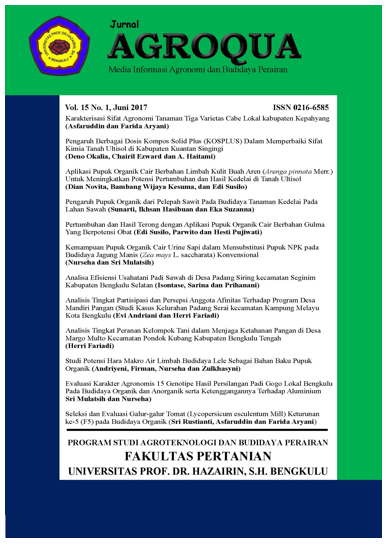APLIKASI AZOLLA (Azolla microphylla) DAN MIKORIZA TERHADAP PERTUMBUHAN SORGUM (Sorghum bicolor (L.) Moench) PADA TANAH ULTISOL
-
DOI:
https://doi.org/10.32663/ja.v21i1.3544Keywords:
Biofertilizer, food, suboptimalAbstract
The formulation of the problem in this study is that the increasing population is the main challenge for the stability of food availability to meet food needs. The importance of alternative feeds to increase food availability as a source of carbohydrates with less optimal utilization, especially ultisols. This study aims to determine the effectiveness of the application of azolla and mycorrhiza on the growth of sorgum on ultisol soil. This research was carried out in the laboratory and experimental field of the agrotechnology study program, faculty of plant sciences and animal, bina insan lubuklinggau university. This study used a factorial randomized block design (RBD) method. The treatments tried in this study was without azolla dan mycorrizhal fertilizers (PH0), azolla 30 fertilizer (PH1), 30 g azolla fertilizer + 20 g mycorrhizal (PH2), 20 g mycorrhizal fertilizer (PH3) and the second factor was the type of sorghum which included: numbu varieties (V1), black varieties (V2), and pahat varieties (V3). The results of this study were that the application of 30 g azolla fertilizer + 20 g mycorrhiza (PH2) gave the best results on plant height, number of leaves and root length of sorghum, the use of numbu sorghum varieties gave the best results on sorghum productivity on ultisol soil and the interaction of azolla fertilizers. 30 g + 20 g mycorrhiza and numbu sorghum varieties (PH2V1) gave the best results on sorghum growth on ultisol soils.
References
Downloads
Published
Issue
Section
License
Authors who publish with this journal agree to the following terms:
- Authors grant the journal right of first publication with the work simultaneously licensed under a Creative Commons Attribution 4.0 Internasional (CC BY 4.0) Licence that allows others to use and share the work with an acknowledgment of the work's authorship and initial publication in this journal.
- The author(s) still hold the copyright of his/her/their work and retain publishing rights without restrictions such as (but not limited to) patent right, lecture, book and reproduce the article for own purposes.
















